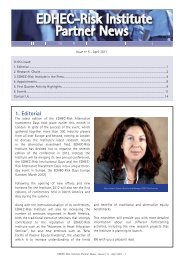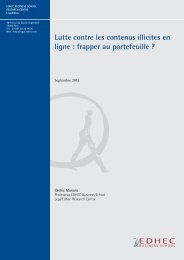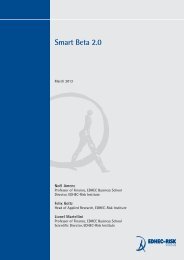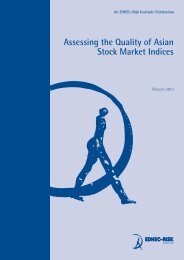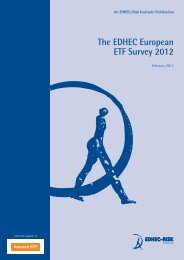The Smart Beta 2.0 Approach - EDHEC-Risk
The Smart Beta 2.0 Approach - EDHEC-Risk
The Smart Beta 2.0 Approach - EDHEC-Risk
Create successful ePaper yourself
Turn your PDF publications into a flip-book with our unique Google optimized e-Paper software.
An ERI Scientific <strong>Beta</strong> Publication — <strong>Smart</strong> <strong>Beta</strong> <strong>2.0</strong> — April 2013<br />
Copyright © 2013 ERI Scientific <strong>Beta</strong>. All rights reserved. Please refer to the disclaimer at the end of this document.<br />
39<br />
Appendix: Overview of <strong>Smart</strong> <strong>Beta</strong> Equity Portfolios<br />
<strong>Risk</strong> Parity (RP, also known as Equal <strong>Risk</strong> Contribution or ERC)<br />
and Diversified <strong>Risk</strong> Parity (DRP) Portfolios<br />
<strong>The</strong> starting point in this approach consists of recognising that contribution to risk is not proportional<br />
to dollar contribution. To see this, we use the following decomposition for the portfolio volatility:<br />
where wi is the portfolio weight and σ p the portfolio volatility. Hence, we define the contribution<br />
to risk as:<br />
To correct for these imbalances, and to generate portfolios that are better diversified in the sense of<br />
exhibiting a more balanced contribution to risk by the constituents of the portfolio, Qian (2005) and<br />
Maillard, Roncalli and Teiletche (2010) suggest to form so-called equal risk portfolios by choosing<br />
the portfolio weight w i so that for all i, j:<br />
(see Qian, 2005, or Maillard, Roncalli and Teiletche, 2010, for more details). It should be noted that<br />
no analytical solution is available to this program, which therefore needs to be solved numerically.<br />
However, in a recent paper Clarke et al. (2013) provide a semi-analytical solution. <strong>The</strong> RP portfolio<br />
weights can be written as:<br />
Here the beta β =( β 1 ,..., β N ) is the vector of betas with respect to the RP portfolio, hence portfolio<br />
weights for the <strong>Risk</strong> Parity portfolio appear on both sides of the equation, which needs to be solved<br />
numerically.<br />
In an attempt to rationalise equal-risk contribution portfolios (also known as <strong>Risk</strong> Parity portfolios),<br />
Maillard, Roncalli and Teiletche (2010) show that risk-parity portfolios would be optimal Maximum<br />
Sharpe Ratio (MSR) portfolios if all Sharpe ratios are identical for all stocks, and if correlations are<br />
identical for all pairs of stocks, obviously a very restrictive assumption.




